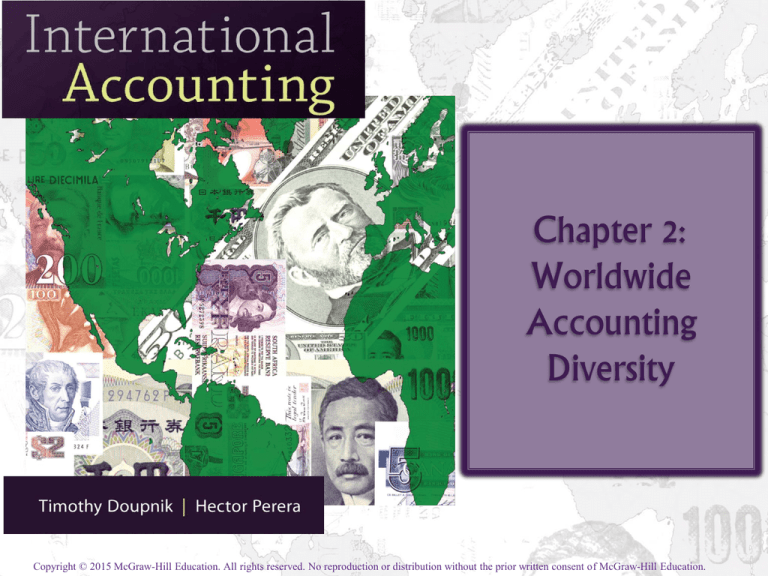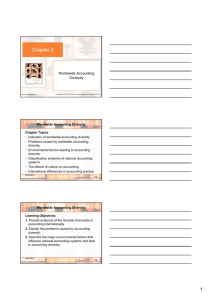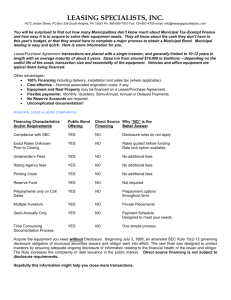
Chapter 2:
Worldwide
Accounting
Diversity
Copyright © 2015 McGraw-Hill Education. All rights reserved. No reproduction or distribution without the prior written consent of McGraw-Hill Education.
Learning Objectives
Provide evidence of the diversity that exists in accounting
internationally
Explain the problems caused by accounting diversity
Describe the major environmental factors that influence national
accounting systems and lead to accounting diversity
Describe a judgmental classification of countries by financial
reporting system
Discuss the influence that culture is thought to have on financial
reporting
Describe a simplified model of the reasons for international
differences in financial reporting
Categorize accounting differences internationally and provide
examples of each type of difference
2-2
Worldwide Accounting Diversity
Nature of diversity in accounting
Format
Terminology
Recognition rules
Measurement rules
2-3
Worldwide Accounting Diversity: Reasons
Legal systems
Common law
Fewer statutes—more court interpretation
Creation of precedents or case laws
Great Britain and other English-speaking countries
Accounting law is detailed and specific
Sources are nonlegislative organizations
Code law
More statutes
Non-English-speaking countries
Legislated accounting rules
Accounting law is general
Other guidance required
2-4
Worldwide Accounting Diversity: Reasons
Basis for taxation
Published financial statements
Germany—same taxable income and book income
Financial statements adjusted for tax purposes
U.S.—different taxable income and book income
Difference between tax and accounting income gives rise to
deferred income taxes
Providers of financing
Accounting and disclosure is less important where major
sources are families, banks, and the government
Accounting and disclosure is more important where major
sources are diverse shareholders
2-5
Worldwide Accounting Diversity: Reasons
Inflation
Some countries have historically high rates of inflation
Necessitates adjustments to offset inflation
Common in Latin American countries
Political and economic ties affect how accounting rules are
conveyed
Correlation of factors
Common law countries have domestic listed companies relying
on equity for capital.
Code law countries tend to link taxation to accounting
statements and rely less on financing provided by
shareholders
2-6
Problems caused by Accounting Diversity
Preparation of consolidated financial statements
Access to foreign capital markets
Comparability of financial statements
Lack of high-quality accounting information
2-7
Preparation of Consolidated Financial Statements
Problems due to:
Local regulations
Books In local currency
Local accounting principles
Requires:
Considerable effort
Additional cost
Expertise in different country’s accounting standards
2-8
Access to Foreign Capital Markets
Requires financial statements as per local accounting
standards
Considerable effort and cost involved
2-9
Comparability of Financial Statements
Lack of comparability between financial statements from
different countries
This adversely affects:
Investment decisions
Lending decisions
Performance analysis
Foreign acquisition decisions
2-10
Lack of High-Quality Accounting Information
Lack of high-quality accounting standards
Inadequate risk assessment
Lack of appropriate disclosure requirements
Disclosure deficiencies
Related-party transactions and off-balance-sheet financing
High exposure to foreign exchange risk
Investments in highly speculative assets
Contingent liabilities guaranteeing foreign currency loans
Loan loss provisions
2-11
Accounting Clusters
Accounting models
The Fair Presentation/Full Disclosure Model (Anglo-Saxon or
Anglo-American model)
Oriented toward the decision needs of large numbers of
investors and creditors
Used in English-speaking countries influenced by the United
Kingdom or the United States
The Legal Compliance Model (Continental European model)
Legalistic
Used to provide information for taxation and governmentplanning
Used in Europe, Japan, and code law countries
The Inflation-Adjusted Model
Resembles the Continental European model
Requires extensive use of adjustments for inflation
2-12
Judgmental Classification of Financial Reporting
Systems
Developed by Nobes
Micro-based—Anglo-Saxon model
Macro-uniform—Continental European model
2-13
Micro-based accounting systems
First sub-class influenced by
Business economics
Accounting theory
Example: Netherlands
Second sub-class influenced by
Business practice
Pragmatic
Example: British-origin
United Kingdom and United States dominated
2-14
Macro-uniform accounting systems
First sub-class:
Aligned with national economic policies
Example: Sweden
Second sub-class:
Continental: government, tax, legal
Example: Continental European countries
Law-based family: Germany, Japan
Tax-based family: Southern European countries
2-15
Exhibit—2.5 Nobes’s Judgmental Classification
2-16
Influence of Culture on Financial Reporting
Hofstede’s cultural dimensions
Gray’s accounting values
Religion and Accounting
2-17
Hofstede’s cultural dimensions
Four cultural dimensions
Individualism (vs. collectivism)
Preference for a loosely knit social fabric
Power distance
Acceptance of hierarchy and unequal power distribution
Uncertainty avoidance
Comfort level with uncertainty and ambiguity
Masculinity
Emphasis on masculine values vs. feminine values
Long-term orientation
Focus on fostering virtues oriented towards future rewards
2-18
Gray’s Accounting Values
Four widely recognized accounting values to describe a
country’s accounting subculture
Professionalism vs. Statutory Control
Uniformity vs. Flexibility
Conservatism vs. Optimism
Secrecy vs. Transparency
Believes that national cultural values affect accounting
values
Accounting values of conservatism and secrecy have the
greatest relevance
Gray extended Hofstede’s model to understand how
culture influences the corporate reporting systems
2-19
Exhibit—2.8 Framework for Accounting Systems
Development
2-20
Religion and Accounting
Religion defines
National culture in many parts of the world
It has significant effect on business practice
Example: Banking companies under Shariah, the Islamic law
of human conduct derived from the Koran
2-21
A Simplified Model to Explain Financial Reporting
International Differences
Nobes’s model argues that international reporting differences
are due to different purposes
Country’s financing system is considered most relevant factor to
determine the purpose of financial reporting
Nobes divides reporting systems into two classes—A and B
Class A
Strong equity-outsider system
Less conservative
Extensive Disclosure
Accounting practice differs from tax rules
Weak equity-outside shareholder financing
More conservative
Disclosure is not extensive
Accounting practice follows tax rules
Class B
2-22
Further Evidence of Accounting Diversity
Categories based on accounting differences
Financial statements included
Financial statement formats
Level of detail in financial statements
Terminology
Disclosure
Recognition and measurement
2-23
End of Chapter 2
2-24




